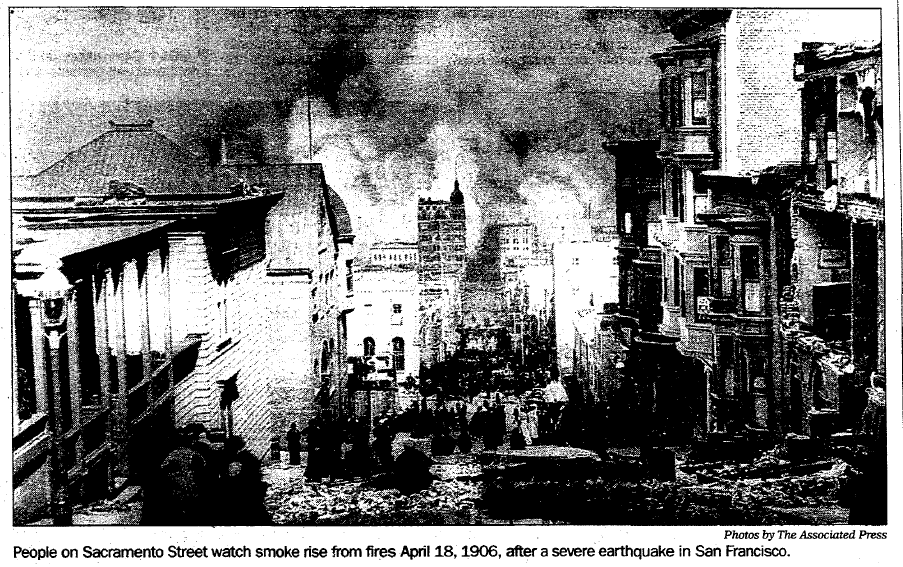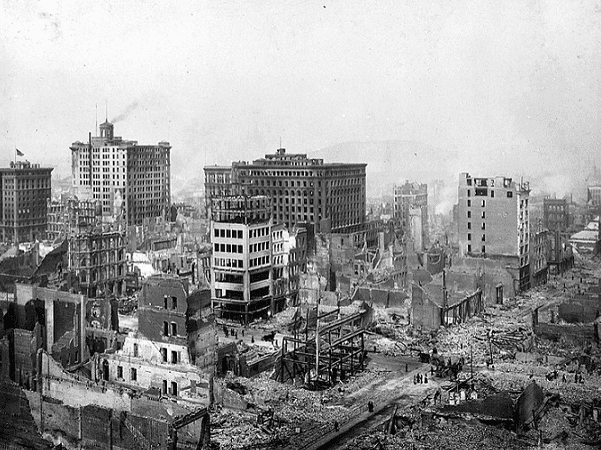It was early on a Wednesday morning, with most of the residents of San Francisco peacefully sleeping, when disaster suddenly struck the City by the Bay. At 5:13 a.m. on 18 April 1906 an earthquake tremor for about 20 seconds was followed by a major 7.9 magnitude earthquake that shook the city for over 40 seconds, jolting terrified residents awake as buildings collapsed around them.

Earthquake Leaves 80% of San Francisco Destroyed
Worse still, the powerful quake twisted and broke gas and water lines across San Francisco. Huge fires erupted and burned continuously for three days. Without water, firefighters were helpless to stop the blazing inferno. In their desperation they resorted to dynamiting buildings to create firebreaks, but these explosions caused additional fires, causing more harm than good.

At the time of the disaster San Francisco was the greatest city on the West Coast America’s ninth largest with a population of 410,000, a bustling center of commerce and art. Three days after the earthquake of 1906 struck, 500 city blocks—over 25,000 buildings—had been smashed or burned; the earthquake and fire combined to destroy over 80 percent of the city.
Because so many bodies burned in the fierce, towering flames that leapt from building to building, the actual death toll will never be known, but it is estimated that more than 3,000 people died in the tragedy. Around 300,000 people, or nearly three out of every four residents, were left homeless after the smoke cleared. San Francisco would of course rebuild, but many beautiful buildings and civic treasures, and thousands of residents, were gone forever.

News of the S.F. Earthquake Hits the Headlines
News of the earthquake flashed over the telegraph wires before the city’s telegraph buildings were destroyed, and made the front pages of newspapers everywhere.
This news report was published by a Rhode Island newspaper.
As this historical newspaper article reports:
Shortly after daylight, while the residence portion of the city was slumbering and the streets were practically deserted save for those whose duties required their presence at the break of day, there came a rumbling that startled the sleepers from their beds and in a moment more the buildings were crumbling about their heads.
Pandemonium ensued. Half-clad men and women rushed from their houses, many of the latter dragging shrieking children by the arms. In many cases the refugees met death in the streets.
Earthquake Survivors Tell Their Personal Stories
After some of the refugees had gotten safely out of San Francisco their stories started to appear in the press, providing many grim details of the death, destruction and panic caused by the massive earthquake and fire. This personal account of the earthquake was published by a North Carolina newspaper.
This first-person account provides the following details:
I returned to my room and got my clothing; then walked to the offices of the Western Union in my pajamas and bare feet to telegraph to my wife in Los Angeles. I found the telegraphers on duty, but all the wires were down. I sat down on the sidewalk, picked the broken glass out of the soles of my feet and put on my clothes. All this I suppose took 20 minutes. Within that time, below the Palace Hotel, buildings for more than three blocks were a mass of flames, which spread to other buildings.
People by the thousands were crowded around the ferry station. They clawed at the iron gates like so many maniacs. They sought to break the bars, and failing in that turned on each other. After a maddening delay, we got aboard the boat and crossed the bay.
Looters Pillage the City
This old news article reports that, sadly, some unscrupulous people took advantage of the earthquake victims, looting in the aftermath:
This newspaper article provides these details:
The scene at the Mechanics Pavilion during the early hours and until noon, when the injured and dead were removed because of the threatened destruction of the building by fire, was one of indescribable sadness. Sisters, brothers, wives and sweethearts searched eagerly for some missing dear one. Thousands of persons hurriedly went through the building inspecting the cots on which the sufferers lay, in the hope that they would find some loved one that was missing.
The dead were placed in one portion of the building and the remainder was devoted to hospital purposes. After the fire forced the nurses and physicians to desert the building the eager crowds followed them to the Presidio and the children’s hospital, where they renewed their search for missing relatives.
Were your ancestors impacted by the 1906 San Francisco earthquake and fires? Along with news reports of the disaster, another way newspapers can help you research your ancestors is the steady stream of casualty reports and lists that were published for weeks after the earthquake struck.
Earthquake Casualties
This report, published in a Texas newspaper, tells of the fate of locomotive engineer William Burnip, 55, whose “remains were dug from the ruins of the house by his son.”
Earthquake Survivor Stories Continue to Run
Long after the disaster, newspapers published stories about the survivors. San Francisco long marked the earthquake’s anniversary with a dawn ceremony, to which all of the earthquake survivors were invited.
As the following newspaper article reports:
…the annual observance that culminates with a dawn wreath-laying at Lotta’s Fountain, a landmark that served as a meeting point for those trying to find families and friends after the disaster.
This article shows a picture of Herbert Hamrol, a survivor of the 1906 earthquake who was 102 years old in 2005.
If your ancestors were alive during a great historical event, tragedy, or natural disaster, old newspapers such as GenealogyBank’s online Historical Newspaper Archives are a great way to learn more about the times your ancestors lived in—and possibly learn details about their actual personal experiences.
